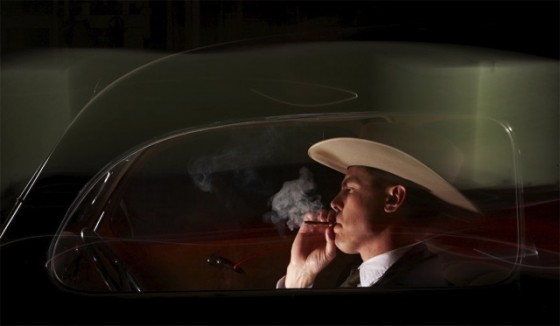The Killer Inside Me is an interesting adaptation of Jim Thompson‘s dark 1952 novel, although like a lot of films tagged as ‘controversial’ is neither as accomplished or shocking as its reputation might suggest.
Set in a small Texas town, it is the story of a deputy sheriff (Casey Affleck) who is a closet sociopath, covering up his corrupt ways with increasingly cunning and desperate actions.
Among the people who cross his path are a local prostitute (Jessica Alba), his schoolteacher girlfriend (Kate Hudson), the Sheriff (Tom Bower), a local businessman (Ned Beatty), a local union leader (Elias Koteas), the suspicious county attorney (Simon Baker) and a grizzled lawyer (Bill Pullman).
For director Michael Winterbottom, it represents another change of direction in a genre-hopping career which has seen him tackle the novels of Thomas Hardy and Laurence Sterne, the siege of Sarajevo, the Manchester 80s music scene, Afghan refugees, the Tipton Three, the death of Daniel Pearl and a family drama set in Genoa.
Only the second film he’s made set in America, it is a reasonably compelling portrait of Thompson’s literary vision.
John Curran‘s script captures the action and tone of the novel in an efficient manner, using for voiceover to clever effect by drawing us closer to the central character.
The production design and period detail paint a convincingly grimy portrait of small town 50s America, where corruption and dark deeds simmer beneath the surface of a society about to undergo major convulsions.
Unusually for this material, Winterbottom and regular cinematographer Marcel Zyskind have opted for a fairly bright visual palatte, which gives the action a strange and arresting quality in contrast with the shadows and dutch angles reminiscent of classic film noir.
Given that his character dominates the film, much hinges on the performance of Affleck in the lead role, and he is memorably creepy, managing to convey the pathological thinking and sinister charm of someone in a dangerous position of authority.
There are eerie similarities with his role in The Assassination of Jesse James by the Coward Robert Ford (both characters even share the name Ford) and he is fast becoming one of the most interesting actors currently working in Hollywood.
The other performances aren’t quite on the same level, although Beatty and Pullman fit their roles very nicely, and it is a shame that Alba and Hudson feel miscast in their roles, despite containing some of their best work in quite some time.
Overall, it is an impressive adaptation with some fine acting but there is something missing in how the film moves along. At times the languid pacing and mumbling dialogue become distracting, especially when a lot of narrative threads are being weaved and eventually tied up.
This is apparent in the disappointing climax, which not only stretches credibility but is also a little overcooked in terms of the visuals and action.
Given the controversy surrounding this film at Sundance and on its recent UK release, you might be forgiven for thinking that this is one of the most violent films in recent memory.
There are two disturbing sequences (one of which is particularly brutal), but by modern standards of they don’t really compare with the violence in films like Irreversible (2002), Switchblade Romance (2003), Hostel (2006), or the Saw sequels.
I can only assume that some of the more ludicrous attacks are by journalists unaware of how violent some modern films have become and were further stoked by the fact that violence was meted out on female characters.
But is the shocking nature of the acts on screen dictated solely by gender? Is violence somehow less shocking if done to a man? A child? An animal?
In the context of the film, surely the sequence raising most hackles is there to accurately depict the emotional and physical destruction wrought by violence? It is hard to watch, but then it is meant to be.
Some critics have labelled Winterbottom and the film as ‘misogynist‘ because the male characters don’t suffer as much as the females. This is perverse logic. Do we need quotas on how many male and female characters suffer on screen?
When it comes to the climactic scene, another sequence that has caused anger, a certain character’s actions are sadly plausible and, in any case, surely the aim of these scenes was to render Thompson’s material faithfully?
Cinema is a medium with a unique directness and throughout its history many films have pushed the social boundaries with The Wild Bunch (1969), Straw Dogs (1971), A Clockwork Orange (1971) and Reservoir Dogs (1992) all attracting controversy for the way in which they depicted violence.
But I doubt if The Killer Inside Me will actually be remembered alongside these landmark controversies.
It is an accomplished adaptation, not without its flaws, and when future audiences stop to consider the film, they will have the benefit of doing so without the reductive shrieking from the media sidelines.
> Official site
> The Killer Inside Me at the IMDb
> Find out more about Jim Thompson at Wikipedia
